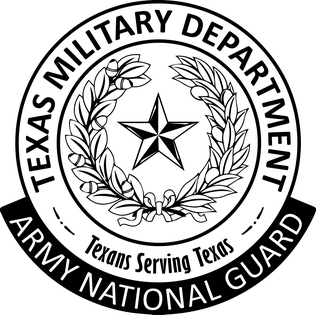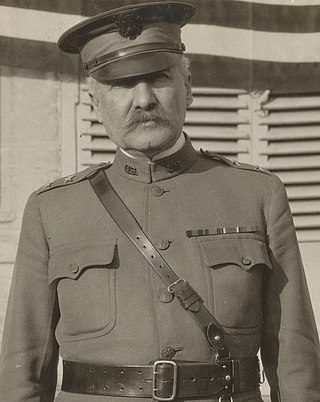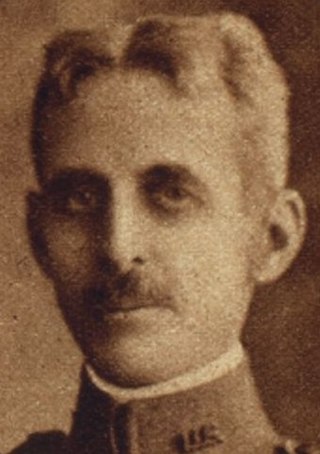
The 81st Readiness Division ("Wildcat") was a formation of the United States Army originally organized as the 81st Infantry Division during World War I. After World War I, the 81st Division was allotted to the Organized Reserve as a "skeletonized" cadre division. In 1942, the division was reactivated and reorganized as the 81st Infantry Division and served in the Pacific during World War II. After World War II, the 81st Infantry Division was allotted to the Organized Reserve as a Class C cadre division, and stationed at Atlanta, Georgia. The 81st Infantry Division saw no active service during the Cold War and was inactivated in 1965.

The 42nd Infantry Division (42ID) ("Rainbow") is a division of the United States Army National Guard. The 42nd Infantry Division has served in World War I, World War II and the Global War on Terrorism (GWOT). The division is currently headquartered at the Glenmore Road Armory in Troy, New York.

The 85th Infantry Division also known as "Custer Division" was an infantry division of the United States Army in World War I and World War II. It currently exists as the 85th Support Command.

Shoulder sleeve insignia (SSI) are distinctive cloth patches worn on the left sleeve of the United States Army uniform just below the shoulder seam by soldiers assigned to divisions, corps, armies, and other specifically authorized organizations. They are also worn on the right sleeve by soldiers to indicate former overseas service with certain units during periods of U.S. military operations in hostile conditions (MOHC).

Lieutenant General James Guthrie Harbord was a senior officer of the United States Army and president and chairman of the board of RCA. During World War I, he served from mid-1917 to mid-1918 as chief of staff of the American Expeditionary Forces (AEF), commanded by General John J. Pershing, before commanding a brigade and briefly a division and then the Services of Supply of the AEF. In the former role he was, in the words of former soldier-turned historian David T. Zabecki,
The U.S. Army's first modern operational-level chief of staff in a combat theater, and he would be the model for all others who followed. He played a key role in developing the staff structure and organization used throughout the U.S. military to this day, as well as by most NATO countries. He was one of the most influential U.S. Army officers of the early 20th century.

The United States Army Forces Command (FORSCOM) is the largest United States Army command. It provides expeditionary, regionally engaged, campaign-capable land forces to combatant commanders. Headquartered at Fort Liberty, North Carolina, FORSCOM consists of more than 750,000 active Army, U.S. Army Reserve, and Army National Guard soldiers. FORSCOM was created on 1 July 1973 from the former Continental Army Command (CONARC), who in turn supplanted Army Field Forces and Army Ground Forces.

The Texas Army National Guard is a component of the United States Army, the United States National Guard and the Texas Military Forces.

The 39th Infantry Division was an infantry formation of the Army National Guard, originally formed as the 18th Division in 1917. The division consisted of troops from Arkansas, Louisiana, and Mississippi. After training at Camp Beauregard, Louisiana, the division was deployed to France but did not see combat before the end of World War I. In July 1923 the division was re-designated as the 31st Infantry Division. The 39th Infantry Division was reactivated after World War II with troops from Louisiana and Arkansas and its headquarters in Louisiana. In 1967, the 39th Infantry Division was reorganized to become the 39th Infantry Brigade (Separate). Its headquarters was in Little Rock and the unit consisted entirely of troops from Arkansas.

Major General Omar Bundy was a career United States Army officer who was a veteran of the American Indian Wars, Spanish–American War, Philippine–American War, Pancho Villa Expedition, and World War I.

Harry Dwight Chamberlin was a career officer in the United States Army. A veteran of the Moro Rebellion, Pancho Villa Expedition, World War I, and World War II, he attained the rank of brigadier general, and was most notable for his command of several Cavalry units, including 1st Squadron, 8th Cavalry Regiment, 1st Squadron, 14th Cavalry Regiment, 2nd Cavalry Regiment, the Cavalry Replacement Center at Fort Riley, and 4th Cavalry Brigade, 2nd Cavalry Division. During World War II, he commanded the New Hebrides Task Force, Southwestern Security District, and Fort Ord.

Major General George Windle Read was a senior United States Army officer who was prominent as a corps and division commander in World War I. Read also oversaw the departure of US forces from Europe at the end of the war as commander of the American Embarkation Center at Le Havre, France.

The United States Army Central, formerly the Third United States Army, commonly referred to as the Third Army and as ARCENT, is a military formation of the United States Army that saw service in World War I and World War II, in the 1991 Gulf War, and in the coalition occupation of Iraq. It is best known for its campaigns in World War II under the command of General George S. Patton.

Major General William Hartshorne Johnston Jr. was a United States Army officer who served his country with distinction for almost forty years, being involved in the Spanish–American War, the Philippine–American War and World War I. He attained the rank of major general, and was most notable for his World War I command of the 91st "Wild West" Division.

David C. Shanks was a career officer in the United States Army. A graduate of the United States Military Academy, he attained the rank of major general, and was a veteran of the Spanish–American War, Philippine–American War, and World War I. He was most notable for his command of the Hoboken Port of Embarkation and 16th Division during the first World War, and was a recipient of the Army Distinguished Service Medal and Navy Distinguished Service Medal.

Bruce Magruder was a career officer in the United States Army. A veteran of the Moro Rebellion, Pancho Villa Expedition, World War I, and World War II, he attained the rank of major general. Magruder was most notable as the first commander of the 1st Armored Division and commander of the Infantry Replacement Center at Camp Wolters, Texas, during World War II.

Evan M. Johnson was a career officer in the United States Army. A veteran of the Apache Wars, Spanish–American War, Philippine–American War, occupation of Veracruz, and World War I, he was most notable for his First World War command of the 154th Infantry Brigade, 158th Infantry Brigade, 77th Division, and 79th Division.

Joseph D. Leitch was a career officer in the United States Army.

John E. Woodward was a career officer in the United States Army. A veteran of the Spanish–American War, Philippine–American War, Moro Rebellion, Pancho Villa Expedition, and World War I, he served from 1892 to 1934 and attained the rank of brigadier general. Woodward was most notable for his command of the 113th Infantry Regiment, Camp Upton, 152d Depot Brigade, 24th Infantry Brigade, 151st Depot Brigade, and 12th Division.

John Fitz Madden was a career officer in the United States Army. A veteran of the U.S. response to the Garza Revolution, Spanish–American War, United States Military Government in Cuba, Philippine–American War, Pancho Villa Expedition, and World War I, he attained the rank of brigadier general and was a recipient of the French Legion of Honor (Officer) for his First World War service. Madden served in both high level staff positions, including chief quartermaster of the Pancho Villa Expedition, and important commands, including the 26th Infantry Regiment and the Hawaiian Division's 21st Infantry Brigade.

Lorenzo Dow Gasser was a career officer in the United States Army. A veteran of the Spanish–American War, Philippine–American War, United States Military Government in Cuba, Pancho Villa Expedition, World War I, and World War II, he attained the rank of major general and was a recipient of three awards of the Army Distinguished Service Medal, the Legion of Merit, and the French Legion of Honor (Chevalier). Gasser was best known for his command of the 31st Infantry Regiment as part of the 1932 U.S. response to the Japanese invasion of Manchuria, his service as Deputy Chief of Staff of the United States Army, and his Second World War presidency of the War Department Manpower Board.





















